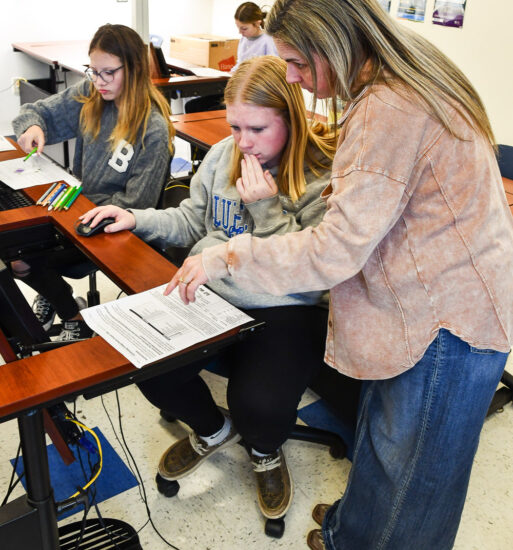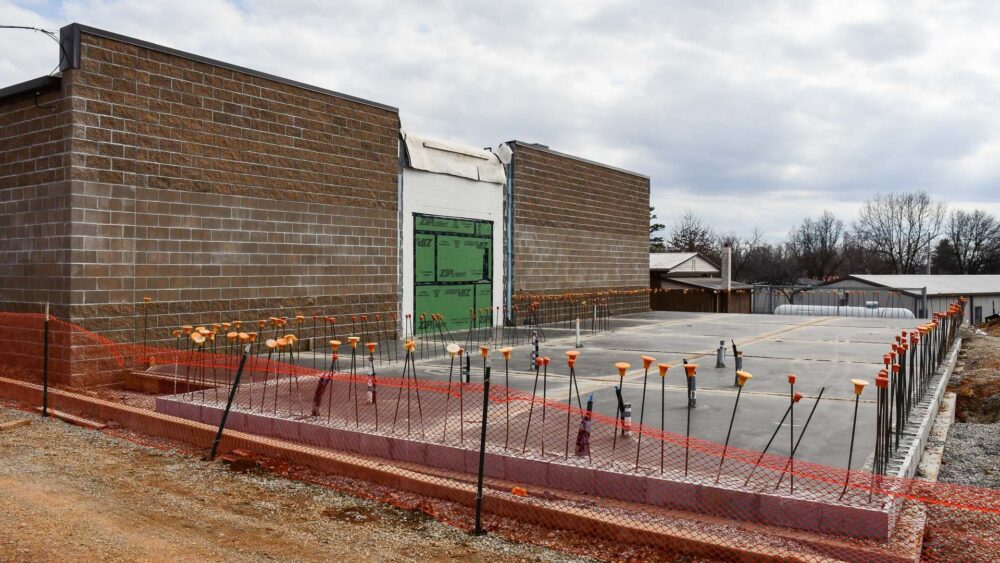CFO Stories
Center of Community
Rural schools may be small in size, but their impact goes beyond the number of students.

Rural schools may be small in size, but their impact goes beyond the number of students.
In days when folks were born, lived and died in small pockets of the Ozarks, rural settlements were where they gathered goods and connections. Those moments have faded in many places, where streets are lined with empty storefronts - reminding us of what was and wondering about what's next.
That question has an answer in small communities that still have a school district. One of those places is Koshkonong, a tiny community in Oregon County where 230 or so students come together for classes and that sense of community.
"The school is the hub," says Seth Bryant, superintendent of the Koshkonong R-3 (Oregon Howell) district. "The community is beyond supportive of the school district. They really are."
Today, the district draws students from near the Missouri-Arkansas state line for preschool through high school. The tight-knit district's graduates are supported in part by the Koshkonong School Betterment Foundation, which is connected with the CFO's Rural Schools Partnership, an effort to support rural districts with options for philanthropy.
The small Oregon County community — today with fewer than 200 people per U.S. Census records — dates to the 1880s.
Named after Lake Koshkonong in Wisconsin — a moniker supposedly bestowed by a railroad man — its early heady days were sweetened by fruit. Specifically, orchards that offered employment and industry as car loads of peaches were shipped out on the train.
"During the early spring, the beauty of blossoms was well worth a trip down the lane next to the railroad," noted an article about Koshkonong years ago in the West Plains Gazette. "Whenever a late frost threatened, the orchards were cloaked in the black smoke of burning tires and smudge pots while men worked throughout the night to protect the peach crop. On better days, the delicate fragrance of the fruit blossoms drifted over the town."
Those days are long gone, but the peach painted on the water tower is a reminder of what was. Other things hold memories, too, like family names and long-held land. Another is the school district, which has been part of life for generations and is small enough to build personal connections - ones that cross with an influx of new faces.

With smaller class sizes, teachers in rural schools like April Mills can build stronger relationships with their students.
Some are folks from across the country who have relocated to more rural areas, searching for farms and greater freedom. Others come into the district during high school. While the majority of Koshkonong's students live within the district, others transfer in from other K-8 schools in neighboring areas for their last four years.
''We get roughly 30 to 35 of those rural school kids that come here for high school every year," Bryant says. "They find their place here and they come right in."
A significant reason those people can come together at the school is the community and support from local farmers, whose acreage is a significant tax base in the Missouri county with nearly 800 square miles.
''Without them, we wouldn't be here," Bryant says.
In his 12 years with the district, there have been three bond campaigns put to voters. Of those, two passed and the other failed by just three votes. That support has led to infrastructure improvements like the FEMA-grade shelter with classroom space that's currently under construction.
That ongoing support doesn't mean that needs don't exist in the district with more than 70 percent of its students qualifying for free or reduced-cost lunches, a metric of poverty.
A factor in that reality is employment opportunities. There are a few jobs at a gas station, home goods store, meat processing plant and the local Dollar General. The latter came to town after locals lobbied the national chain, garnering attention from the likes of even Fortune magazine. Wood products companies also offer employment. But in some cases, those options aren't enough to support local kids.
The school helps fill in gaps through efforts like its backpack program, which sends food home with students in need. In 2022, the school received a $5,000 grant from the CFO and the Louis L. and Julia Dorothy Coover Charitable Foundation to stock a "caring closet" with basic hygiene and clothing supplies.
Another avenue of service and support is the school's Youth Empowerment Project chapter, a CFO program that empowers students to improve their community. (Read more about YEP here.) The Koshkonong chapter is being revived, but its work has included growing a school garden, starting a small store and documenting local history.
"It's looking at what can they do, even as high school kids, to help the school and the community to be better for when they're adults and hopefully come back," says Dr. Jane Ward, YEP advisor, school foundation board member and rural educator with Missouri State University of YEP's goal.
Even as the program finds new footing, the spirit is already there. When a custodian was recently on leave for illness, students in the Family, Career and Community Leaders of America club stepped up to help clean the school.
"This group has been staying after two days a week to help out and clean the high school while our nighttime janitor is recuperating," noted a post on the district's website. "Good job, FCCLA, and what a great endeavor to display community involvement and support."
What about the future? That is a question asked and answered through the Koshkonong School Betterment Foundation, which primarily exists to help fund scholarships for its students as they make plans for their futures.
"The CFO has really been a big benefit for us," Ward says, speaking of the grants, scholarships and matching funds that were options for the school foundation. "Without having the foundation built through CFO support, we wouldn't have the scholarship and the money that we've been able to raise."

With strong support from district voters, school bonds fund infrastructure improvements like this FEMA-grade shelter currently under construction.
One of its recipients — and board members — is Loma Kay Howell, whose family's local ties date to 1926. She graduated from Koshkonong in 2020 and today is working as a nurse.
"They paid for me to go through nursing school, so the least I can do is help them put more kids through school," she says.
Howell's connection is personal, too. When her father died, the school held a benefit for the family — but instead of keeping the money, they used it to open the Greg Howell Memorial Scholarship Fund with the Alton Community Foundation, an affiliate of the CFO.
"We wanted to give back to the community," Howell says. "That way, every year ... somebody would benefit from it."
Even after graduation, the personal connections with the school remain for some alumni.
Riley Villavicencio is a Koshkonong graduate and scholarship recipient studying to become a nurse, a career inspired by his grandmother's journey with cancer. He still comes by the high school once a week or so to say hi and complete work for his college classes.
"I'm working hard when I can over the summer," he says. "It's just helping pay so I don't have to pay so much out of pocket."
The school has also established the Koshkonong Grow Your Own Fund to support teacher recruitment and retention efforts. It's seeded by nearly $10,000 from the Missouri Department of Elementary and Secondary Education.
''When former students from here get admitted to the education program," Bryant says, "then we could give them a scholarship to help defer cost in some way, shape or form."
And it all ties back to the meaning and foundation of where they began.
As Ward puts it, "Strong relationships are built, not just with the kids, but with the parents and families."
By Kaitlyn McConnell • This essay is featured in the spring 2025 edition of Passion & Purpose.
Rural schools are unique and represent the differences that define their region, but there is common ground found in the value they bring to communities. They remain a place of opportunity: For understanding and bridging gaps in addition to literal learning, employment and security.
These beliefs are held locally — and supported by the CFO’s Rural Schools Partnership, which provides a framework of support for rural districts — but are also shared far beyond rural Missouri.
“Rural schools and districts are often one of the largest employers in small towns, and are ground zero for preparing and engaging the next generation of rural residents,” says Taylor McCabe-Juhnke, executive director of the Rural Schools Collaborative, a nonprofit founded by former CFO President Gary Funk in 2014 to build sustainable rural communities across the country through a focus on place, teachers, and philanthropy.
“Additionally, schools themselves serve as a source of public infrastructure, providing a meeting space, social connector for community events, access to health services and supports, and essentially functioning as the hub of the community.”
Of course, there are challenges. Lower teacher salaries and limited housing can be issues to navigate. But they also offer amenities that larger districts may find to be a greater obstacle, such as the interaction and personal connection made possible with fewer students over greater periods of time.
“Many small schools have less bureaucracy or hierarchies than larger districts, smaller class sizes, and teachers interacting with students over multiple years/subjects/grades, which can create the conditions for nimble innovation, timely impact and strong relationships,” McCabe-Juhnke says.
And even if businesses close and the population changes, rural schools anchor a sense of connection for community members — with each other, and their local culture.
“The strong sense of community should not be overlooked as an important perk,” McCabe-Juhnke says. “The community buy-in and support for the school, students and staff often transcends the classroom walls into a culture of interdependence versus isolation.”